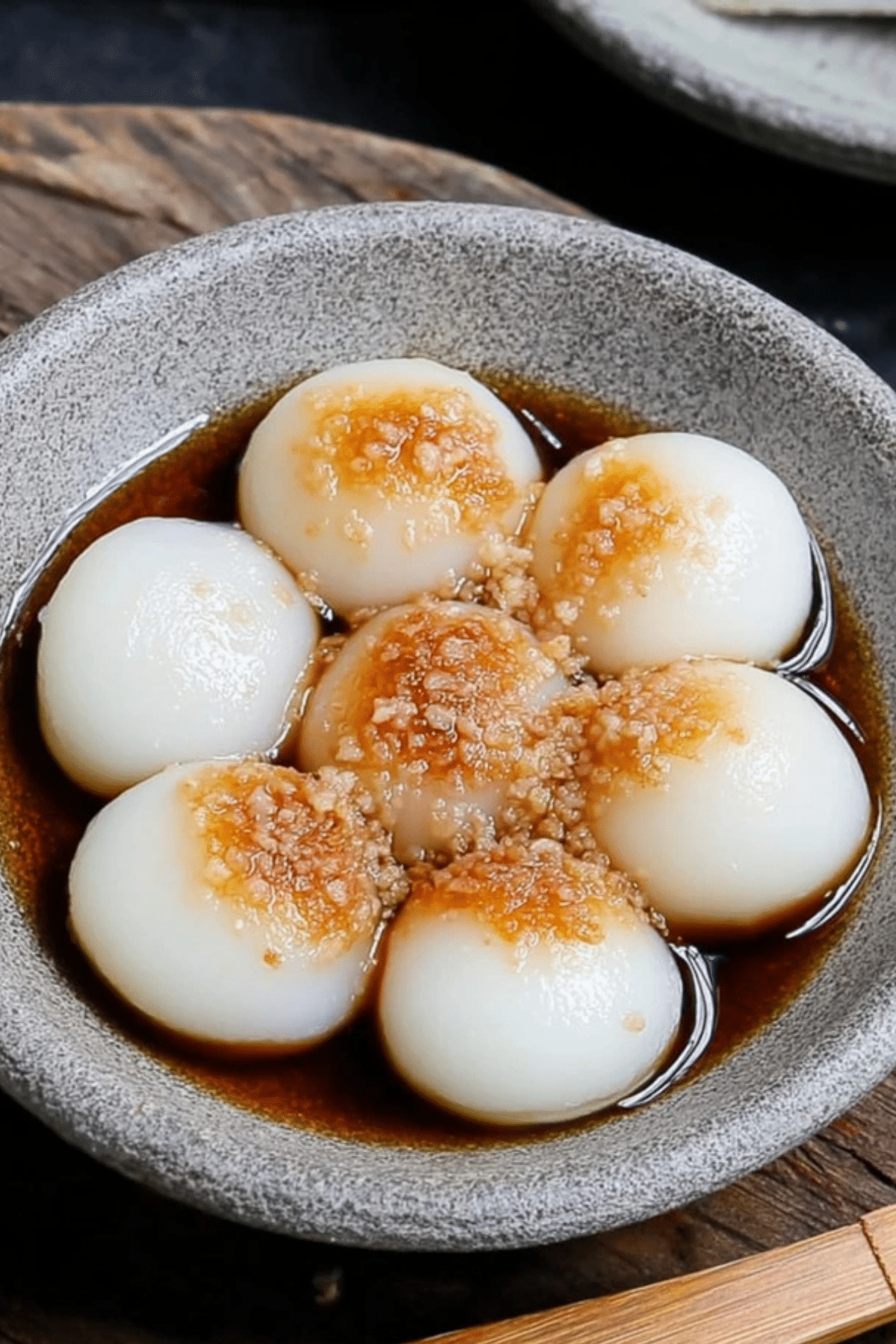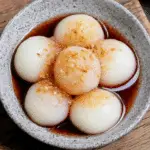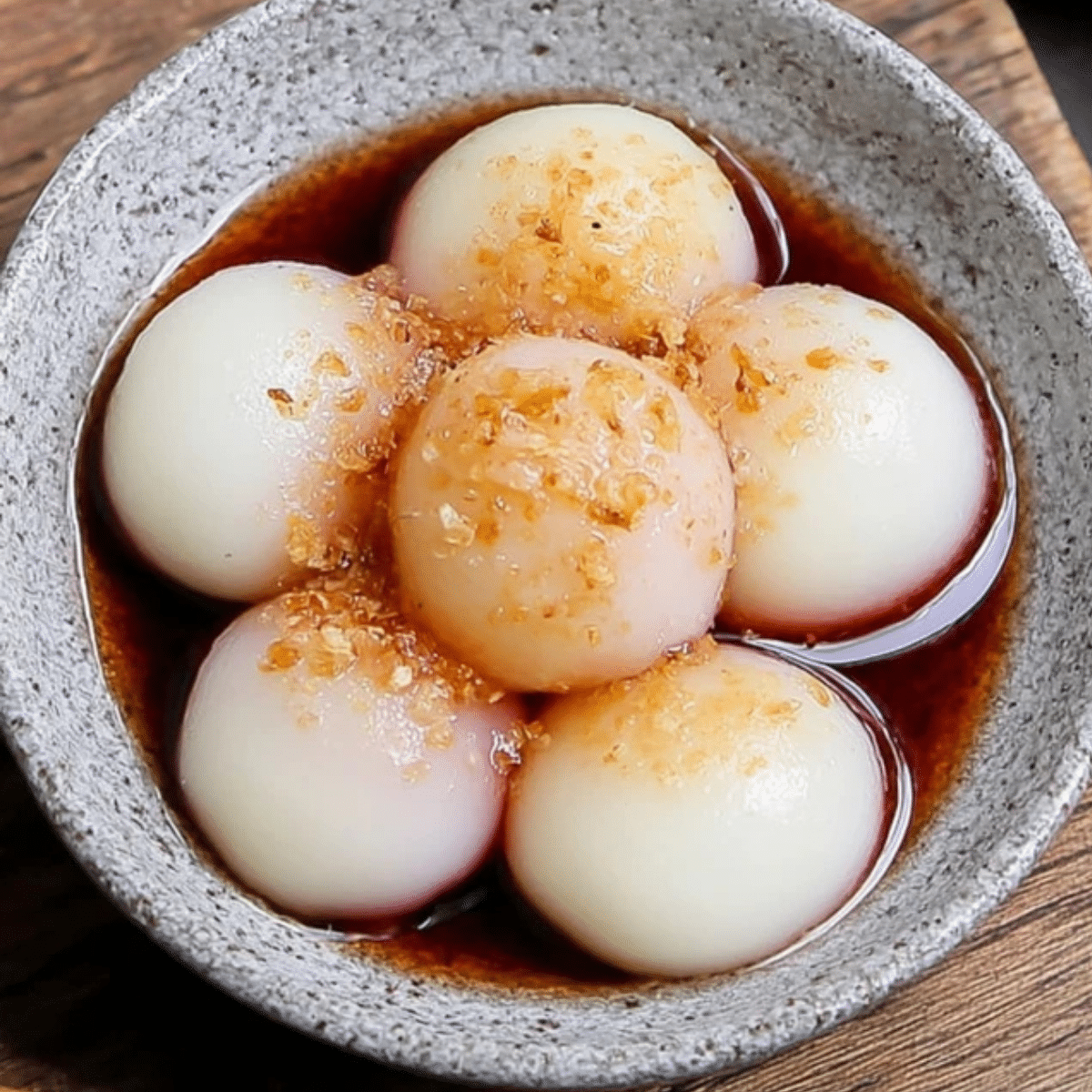Shiratama Dango is a delightful Japanese treat made from chewy, bouncy rice dumplings that are commonly served with sweet syrups or added to other traditional desserts. Known for their smooth texture and delicate flavor, these mochi-like rice balls have become a favorite in many Japanese households. Whether enjoyed with a drizzle of sweet syrup, paired with fruits, or added to ice cream, Shiratama Dango is both simple and versatile, making it an irresistible dessert for any occasion.
Table of Contents
Why You’ll Love Shiratama Dango
Shiratama Dango is incredibly easy to make, with just two main ingredients: glutinous rice flour and water. Unlike other types of dango, which may require more complex preparations, these rice dumplings are quick to assemble, making them perfect for beginner cooks or anyone looking for a satisfying dessert in less than 30 minutes. Their subtle sweetness and bouncy texture make them a perfect addition to a variety of Japanese desserts or even savory dishes, such as hot pots.
Ingredients
- Glutinous Rice Flour (Shiratamako): The base of the dango, providing its chewy, bouncy texture. It is crucial for achieving the perfect mouthfeel that defines Shiratama Dango.
- Water: Hydrates the flour and binds it into a smooth, elastic dough. The amount of water varies, so it’s important to add it gradually.
Ingredient Substitutions
If you cannot find Shiratamako, you can substitute it with Mochiko, another type of glutinous rice flour. However, note that the texture may not be as smooth or chewy. For a softer texture, you can mix in a bit of potato or tapioca starch with Mochiko.
Step-by-Step Instructions
Step 1: Prepare the Dough
Start by placing the Shiratamako into a bowl. Gradually add half of the water and mix until it begins to come together. Slowly add more water, kneading the dough by hand. The dough should have the consistency of an earlobe—smooth, soft, and not too wet. If it’s too dry and cracks when you shape it, wet your hands and knead to add more moisture.
Step 2: Shape the Dango
Once the dough is ready, divide it into small sections and roll each piece into a ball. Press each ball gently in the center to create a small dent—this will help them cook evenly and absorb any syrup you may use later.
Step 3: Boil the Dango
Bring a pot of water to a boil. Gently drop the shaped dango into the pot, stirring occasionally to prevent sticking. Once the dango float to the top, let them cook for about a minute, then remove them using a mesh spoon and transfer them into a bowl of ice-cold water to stop the cooking process.
Step 4: Serve and Enjoy
After cooling, drain the dango and serve them with your favorite toppings, such as dark brown sugar syrup (kuromitsu) and roasted soybean powder (kinako). Shiratama Dango can also be enjoyed with fruits or a scoop of matcha ice cream for a refreshing treat.

Tips & Tricks
- Check the Dough Consistency: If your dough is too wet and sticky, add more glutinous rice flour. If it’s too dry, wet your hands to incorporate a bit more water without making it soggy.
- Chill for Best Results: After boiling, chill the dango in ice-cold water to keep them firm and prevent them from becoming too soft or mushy.
- Storage: While Shiratama Dango is best eaten the same day, you can freeze leftovers. Lay them out on a baking tray, ensuring they don’t touch, and freeze for about an hour. Then, transfer them to a freezer bag. To reheat, soak them in warm water or microwave for about 40 seconds.
Pairing Ideas and Variations
Shiratama Dango is incredibly versatile. You can serve it in a variety of ways to suit your taste:
- Traditional Style: Serve with kuromitsu (a dark sugar syrup) and kinako (roasted soybean powder) for the classic dango experience.
- Creative Toppings: Try adding fresh fruits like strawberries, or drizzle with condensed milk for a sweeter option.
- Savory Variation: Shiratama Dango can even be added to savory dishes like Japanese hot pots (nabe) for a surprising twist.
The Cultural Significance of Shiratama Dango
Shiratama Dango, like many traditional Japanese sweets, is often enjoyed during special occasions or festivals. Its simple yet satisfying texture has made it a staple in Japanese homes. Whether served as part of a grand meal or as a small snack, it represents the beauty of Japanese cuisine—emphasizing simplicity, quality ingredients, and careful preparation.
In addition to its cultural significance, Shiratama Dango is a great dessert to enjoy year-round. It pairs wonderfully with seasonal fruits, making it perfect for both warm and cold months.
Conclusion
Shiratama Dango is a delightful and versatile treat that offers a perfect balance of chewy texture and subtle sweetness. Whether you enjoy it with traditional toppings like kuromitsu and kinako or get creative with fruits and syrups, these little rice dumplings are sure to bring a taste of Japan to your kitchen. Their simplicity in ingredients and ease of preparation make them a great option for both beginners and experienced cooks alike. Give this recipe a try and indulge in the timeless appeal of Shiratama Dango—an easy-to-make, authentic Japanese dessert that’s perfect for any occasion.
FAQ
1. What is the difference between Shiratama Dango and regular dango?
Shiratama Dango is made using a specific type of glutinous rice flour called Shiratamako, which gives it a smoother, chewier texture compared to other types of dango. While other dango varieties may include different flours or flavorings, Shiratama Dango is prized for its subtle, natural sweetness and soft, bouncy consistency.
2. Can I make Shiratama Dango ahead of time?
Yes! While it’s best to enjoy Shiratama Dango on the same day they’re made, you can prepare them in advance and store them in the fridge in a bowl of cold water. This helps preserve their texture. If you have leftovers, you can freeze them by spreading them out on a tray and freezing for about an hour before transferring them to a sealable bag for longer storage.
3. Can I use mochiko instead of shiratamako?
While Shiratamako is the traditional flour used for Shiratama Dango, you can substitute it with mochiko (another type of glutinous rice flour). The texture may not be as soft and chewy, but mochiko will still yield delicious dango. To make the texture closer to that of Shiratamako, try adding a little potato starch or tapioca starch.
4. How do I store Shiratama Dango for later use?
To store Shiratama Dango, place them in a bowl of cold water in the fridge to prevent them from drying out. You can also freeze them for longer storage. Arrange the dango on a tray with parchment paper, freeze them for an hour, and then transfer them to a freezer bag. To reheat, soak them in warm water or microwave them for a quick and easy snack.
More Relevant Recipes
- Pumpkin Cheesecake Bars Recipe: These creamy pumpkin cheesecake bars are an indulgent fall treat. With a rich, velvety texture and hints of cinnamon and nutmeg, they pair perfectly with the subtle sweetness of Shiratama Dango, making them a wonderful dessert duo for autumn gatherings.
- Pumpkin Pie Dip – Easy Recipe: For those looking for a lighter, fun alternative to pumpkin pie, this pumpkin pie dip offers the same warm spices and creamy texture. It’s an ideal companion to serve alongside Shiratama Dango, creating a unique combination of creamy, sweet desserts.
- Apple Cinnamon Jam Recipe – Easy Fall Guide: This sweet and spiced apple cinnamon jam is a fantastic way to complement the neutral sweetness of Shiratama Dango. Spread it over the dango or serve it on the side to enhance the flavor profile with the warm, comforting taste of fall.

Shiratama Dango Recipe
- Total Time: 20 minutes
- Yield: Approximately 20 dango
- Diet: Vegetarian
Description
Shiratama Dango is a soft and chewy Japanese rice dumpling made with glutinous rice flour. It has a mild sweetness and is commonly served with a variety of Japanese desserts, such as Anmitsu and Zenzai. Its bouncy texture makes it a unique and delightful treat to enjoy with different toppings like syrup, fruits, or ice cream.
Ingredients
- 100g Shiratamako (glutinous rice flour)
- 90ml water (approx)
- Optional toppings: Kuromitsu (dark brown sugar syrup), Kinako (roasted soybean powder)
Instructions
- Measure Shiratamako into a bowl and whisk it to break up any lumps.
- Add half of the water and mix with a spatula. Gradually add the rest of the water, kneading by hand until a smooth dough is formed. The dough should have the consistency of an earlobe—soft but not too sticky.
- Divide the dough into small pieces and roll each piece into a ball. Press the center with your thumb to create a small dent.
- Bring a pot of water to a boil. Once boiling, gently drop the dango into the pot, stirring occasionally to prevent sticking. Once they float, cook for an additional minute.
- Remove the dango with a mesh spoon and transfer them to a bowl of ice-cold water to stop the cooking process.
- Once chilled, drain the dango and serve with your favorite toppings like kuromitsu and kinako. Enjoy!
Notes
- If the dough is too dry, wet your hands and knead to add more moisture.
- Ensure the dough is not too soft; if it is, add a little more Shiratamako to firm it up.
- You can store any leftovers in a bowl of cold water in the fridge for a few hours before serving.
- For a savory version, you can serve Shiratama Dango in hot pots or soups.
- Prep Time: 15 minutes
- Cook Time: 5 minutes
- Category: Dessert
- Method: Boiling
- Cuisine: Japanese
Nutrition
- Serving Size: 1 dango
- Calories: 222 kcal
- Sugar: 0.1g
- Sodium: 5mg
- Fat: 1g
- Saturated Fat: 0.2g
- Unsaturated Fat: 0.4g
- Trans Fat: 0g
- Carbohydrates: 53g
- Fiber: 0.2g
- Protein: 4g
- Cholesterol: 0mg

